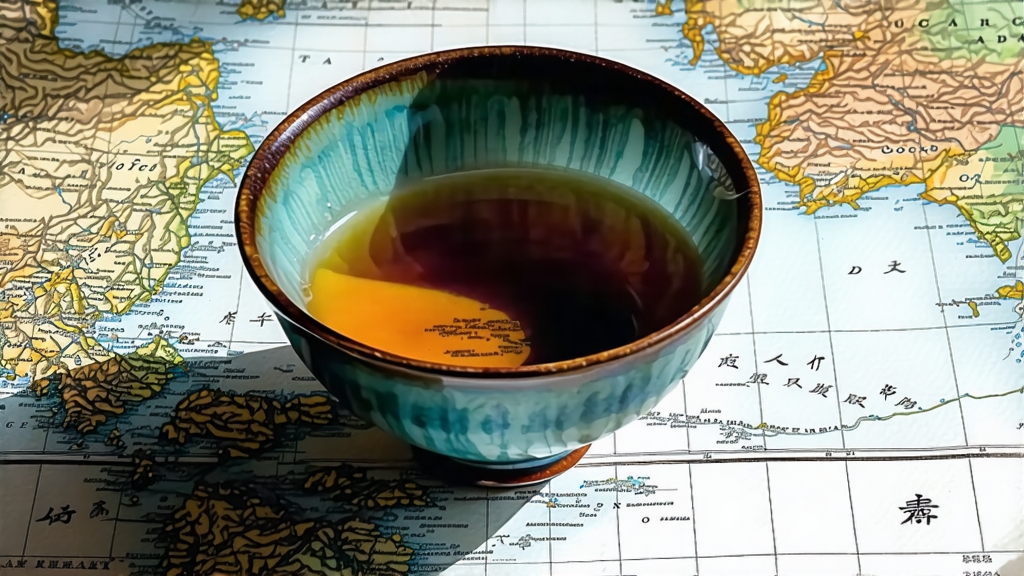
Few beverages carry the quiet gravitas of Fu brick tea (Fú zhuān chá). Compressed into dark, chocolate-brown slabs and flecked with tiny golden spores, it looks almost archaeological—more relic than refreshment—yet one rinse awakens aromas of walnut, wet pine and dried jujube that have enchanted traders, monks and emperors for almost a millennium. To understand why this humble brick from the Hunan–Shaanxi border became the best-selling of all Chinese hei cha (dark teas), one must follow the long camel shadows that once stretched across the Gobi, sniff the cool air of the Qinling tunnels where spores drift like pollen, and finally sit at a modern gongfu table where the same tea still sings.
-
Historical footprints
The story begins in the 1368 Ming dynasty, when the imperial court replaced loose-leaf tribute with compressed “border tea” to reduce weight on the Tea-Horse Road. Tea makers along the Jing River (today’s Jingyang county, Shaanxi) found that the humid summer monsoon encouraged a yellow fungus inside the half-finished bricks. Caravans leaving Xi’an noticed that bricks bearing this “golden flower” (jīn huā, Eurotium cristatum) resisted mold, tasted sweeter after months on pack-saddles, and fetched higher prices in Lhasa and Kashgar. By the Qing era, official “Fu tea offices” supervised 108 licensed workshops; a single 5-kg brick could buy a sheep on the Tibetan plateau. The name “Fu” itself is a contraction of “Fǔyì” (government depot), later softened to the auspicious character meaning “blessing.” After the rail age the caravans vanished, but the bricks remained, quietly aging in monastery storerooms and, more recently, in climate-controlled warehouses in Guangzhou and Hong Kong where collectors treat them like liquid jade. -
Terroir and leaf grade
Authentic Fu brick starts with late-spring coarse leaf plucked at 700–1,200 m in the mist-cooled foothills of the Nanling range (Hunan) or the loess terraces of Jingyang. The bushes are seed-propagated Fuding-type large-leaf that develop thick cell walls, ideal for microbial fermentation. After plucking, the leaf is sorted into four grades: jiān chá (bud-rich tips), sān děng (third grade), sì děng (fourth grade) and cuò chá (mixed stems). Only the latter two, too rugged for green-tea standards, are destined for Fu bricks; their high stem ratio ensures air channels so the fungus can breathe. -
Crafting the golden flower
Production still follows a seven-step rhythm unchanged since the Jiaqing reign:
a. Pan-fire kill-green (杀青) – 280 °C for three minutes deactivates leaf enzymes yet keeps surface microbes intact.
b. Rolling (揉捻) – 40 min light pressure to crack cell walls without juice loss.
c. Piling (渥堆) – 12 h in 85 % humidity at 55 °C; the first wave of bacteria softens fibers.
d. Stewing (汽蒸) – 30 s steam at 105 °C makes leaf pliable for pressing.
e. Inoculation (发花) – the crucial step: steamed leaf is packed into 30 × 18 × 4 cm pine boxes lined with cotton paper. Workers sprinkle a mother culture of Eurotium cristatum spores, then stack boxes in a “flower room” kept at 28 °C and 75 % RH for 7–10 days. During this time the fungus weaves golden filaments, metabolizing starch into sweet polysaccharides and converting catechins into novel theaflavins that give Fu tea its mellow, hay-like sweetness.
f. Drying (干燥) – bricks are moved to a 45 °C hot-air tunnel for 48 h to drop moisture to 9 %.
g. Wrapping (包装) – brown kraft paper and bamboo bark twine seal the brick, ready for decades of post-fermentation.
- From brick to brew: the gongfu approach
International drinkers often mistake Fu brick for puer and brew it accordingly, yielding dull, earthy liquor. Instead, treat it like a spiced Burgundy that needs coaxing:
Equipment – 120 ml porcelain gaiwan or Yixing zi-sha clay (zi-ni) teapot reserved